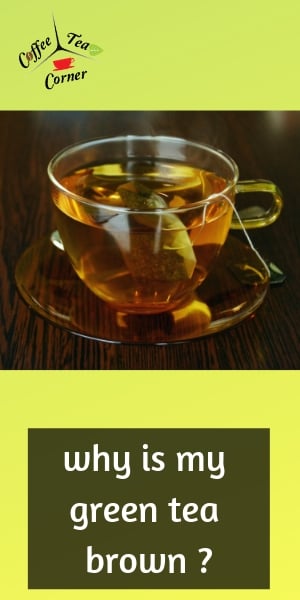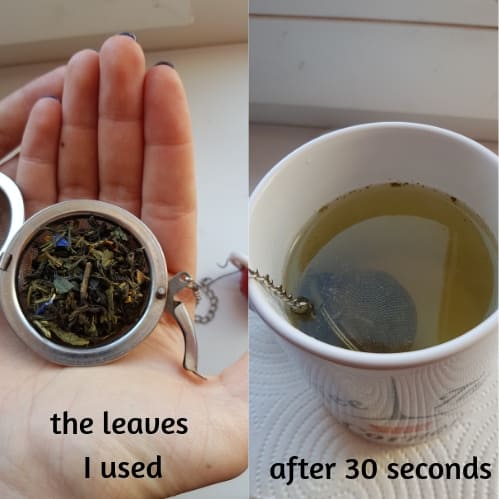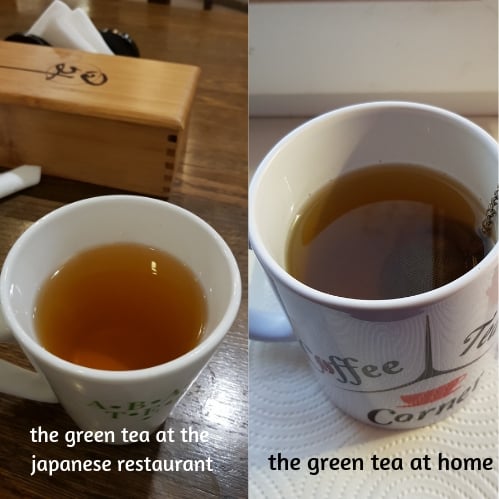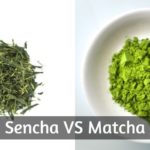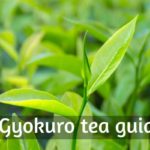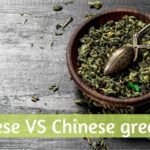Ever made a cup of green tea and was met by a yellowish-brown tea ? I know I have, and there is a definite difference between teas that come out green and those that come out yellow.
I actually made a cup of green tea I had on hand, to check if this one was yellowish too. It was. Delicious, but still not green. The I went to an actual Japanese restaurant and had green tea. Here's what I found.
Table of Contents
Why is my green tea brown ?
Green tea can brew brown if the tea is of inferior quality, or if you've brewed it for too long or used water that is too hot. The only teas that will brew truly green are matcha and Gyokuro tea. If your green tea does not belong to any of those categories, it will likely brew a shade of amber. There's nothing wrong with it.
Exposure to heat in general can make green tea change its color, which is why some cakes or desserts that involve baking and green tea don't always come out green looking.
Aside from this, the way the tea plant is grown can affect the final color of the brew. Green tea is grown in high altitudes, but in the shade. This means that direct sunlight will harm the plant, and will dry it out.
This will affect the color and taste of the ensuing brew, no matter how the leaves are processed after being picked. Please do remember that not many green teas come out actually green. Most come out yellowish.
Why is it called green tea then ?
Green tea does not take its name from the color of the brew, but from the color of the processed leaves. When brewing green tea, you're using dark green leaves. This is why black tea brews dark brown-red, but is still called black. The color of the leaves matters more than the color of the brew, at least by Western naming standards.
The quality and processing of the tea leaves dictates the color
Alright, so you know the leaves themselves dictate the color. Originally, when the leaves are on the tree/shrub and they're not yet picked they are green. Very bright green. They are the younger leaves of the Camellia sinensis plant, and they're only meant to be lightly processed.
This is where things go in two very specific directions.
First, we have the Japanese green tea which means the leaves are just steamed before being rolled, and then dried. They retain their green color more than any other type of green tea.
Matcha, which is the greenest green tea you can find, is a Japanese type green tea. It's dried and crumbled into a fine powder.
The we have the Chinese green teas. These tea leaves are lightly toasted, usually in a skillet, and they oxidize a bit differently than the steamed Japanese versions. We should also take into account that the soil and elevation will differ between Chinese and Japanese green teas.
So all this means is that you will get different quality and color green tea depending on how the tea was processed, how long it was exposed to direct sunlight (if at all), how long ago it was picked and processed, and how well the tea was stored before ending up in your home.
This means that the variations are ridiculously vast, and there is no one green tea like another. Each brand and country and processing style produces different green teas.
There are also cases when an oolong tea (a green tea that is meant to be processed more than other green teas) is mislabeled as Sencha (a type of green tea). This kind of mistakes can get you a cup of perfectly fine tea, but it would look wrong according to what you know is on the label.
(If you like this article so far, you can pin it to your Pinterest board by clicking the image below. The article continues after the image.)
The brewing process can change the color as well
How your brew your tea can make a whole world of difference. What does this mean ? Green tea is very very sensitive to heat, it oxidizes much faster than black tea, and it needs some very specific brewing methods and temperatures.
For example the most common brewing method, the hot brew method involved water than has been bought up to 80 C/176 F and the leaves have been allowed to steep for 2-4 minutes, depending on the brand of tea. Most teas however should not be kept for more than 2 minutes.
This can go wrong in many ways. First, the temperature of the water can be too high or too low. Too high a temperature will yield a bitter, very oxidized tea, which will come out darker, more yellow (brown in some extreme cases).
Brewing your tea at a temperature under 80 C/176 F will possibly get you a greener looking tea, I've never tried it myself. But I assume not all the nutrients will be drawn out of your tea leaves, since some come out faster than others.
Another method of brewing green tea (or any other tea, really) is cold brewing. All this means is the leaves are steeped in room temperature water, and left for 10-12 hours. The steeping process is much slower, and you will get a different flavor from the same green tea you've just made a hot cup.
This type of brewing does no oxidize the tea leaves, so there is no danger of getting a bitter cup of tea or an overly yellow or brown tea infusion. Unless your green tea really has gone stale or has oxidized in time.
There is also the problem of how much tea to add to your particular cup. This all depends on how strong you like your tea, but there are also upper limits. The is such a thing as too much tea to water ratio.
I tried a couple of green tea cups for comparison
I like my tea fairly strong, about an 8 on a 1 to 10 scale. This means I usually use about 2 teaspoons of green tea to 250 ml/8.5 oz of already boiled water. That's how much I used here in this mug, in the tea ball. Steeped at 80 C for 3 minutes.
My particular tea is from Demmers Teehaus (Austrian brand), and it's a green tea with cornflower and sunflower petals. I doubt those contributed to the color of my tea, but here it is, fairly yellowish. It was actually light green in the first 30 seconds since introducing the tea ball and moving it around a bit.
I know this tea blend very well, I've repurchased it for years, and I've tried it in weaker concentrations. The color is the same as this final one, and the tea house I got it from is a fairly good one. All I can say is that the leaves in this tea are most probably not steamed, and possibly not the freshest batch when I bought it.
I'm not unhappy with the taste, but as far as green goes, this is not a green looking tea. However we need to remember that not all green teas are the same. Still, just to rule out the influence of the corn flower and sunflower petals, I've also tried with a simple green tea.
This is from a Japanese restaurant I went to on the same day. I trust them to have at least a decent green tea assortment. As it turns out, their tea came out yellowish as well. It wasn't Gyokuro tea either, but a blend of green tea that they've named themselves.
The green tea that does come out green
As far as I know, and as far as I've seen the only green teas out there that come out definitely green are the types used for Matcha. That's the Gyokuro tea, which is the plain green Japanese tea.
This means that the tea plant is grown in a shaded place, and eventually covered to keep the sun away. This produces darker green leaves, which are them handpicked when the plant is still young (about 3 weeks).
All the leaves picked are de-veined and the stems are removed. This will leave you with only the delicate leaf. From here the process goes 2 ways.
The leaves are rolled up, and dried, and thus produce Gyokuro. In taste it is not very different from Matcha, since it's essentially the same leaf type, grown the same way. But Matcha is processed differently.
For Matcha the leaves are laid out to dry, and they eventually become dry enough to be crumbly. That is when they are stone-milled into a very fine powder, which is them mixed into hot water or milk.
Whichever tea you get, Matcha or Gyokuro, it will still be a green looking green tea. Matcha more so since its powder is famous for the vibrancy. It can be used in anything edible, from food to sweets and even lattes.
A pot of properly Gyokuro tea will have a greenish look about it, while Matcha brewed tea will have a bright green looking liquid. It's important to know that not all green teas actually come out green.
Final thoughts
Alright, I know this was confusing at times to read. But I hope you understand now that not all green teas are meant to come out green and only green.
- The way the plant itself was grown will dictate how green the tea will be.
- Shaded plants produce greener teas.
- Less processed tea leaves produce greener infusions.
- Steamed leaves produce greener infusions than baked or roasted leaves.
- Matcha should never be compared to any other type of green tea since it's simply too different in processing and serving to even be lined up against any steeping tea.
So if you're looking at the color of the tea for any indications of quality, this is not entirely wrong.
You can indeed tell a green tea's quality by the color it gives your infusion, but there are many other elements that will influence the infusion. The brewing time, temperature, method, how the leaves were processed as well.
I recommend looking up local tea houses in your area and trying out a few green teas for yourself. Green tea is pretty much an acquired taste, much like black coffee.
It's not for everyone, but if you're looking for a good one you should know that green tea is not meant to be sweet and fruity like many Western herbal teas.
If you want to know more about coffee or tea, feel free to check the related articles below. Who knows what else you might find ?


